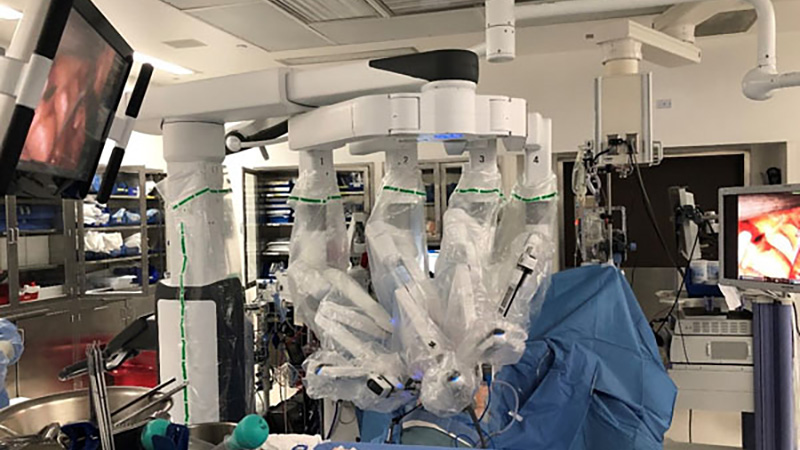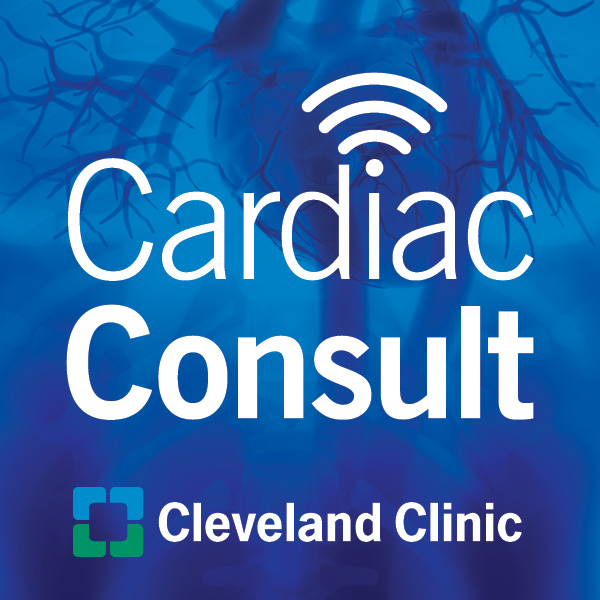Robotic Surgery in Thoracic Patients

Many thoracic surgery cases are now being performed using robotically assisted surgery. Dr. Sudish Murthy and Dr. Usman Ahmad discuss how the robot is used and the types of procedures that benefit from this minimally invasive approach.
Subscribe: Apple Podcasts | Podcast Addict | Buzzsprout | Spotify
Robotic Surgery in Thoracic Patients
Podcast Transcript
Announcer:
Welcome to Cleveland Clinic Cardiac Consult, brought to you by the Sydell and Arnold Miller Family Heart, Vascular and Thoracic Institute at Cleveland Clinic.
Dr. Sudish Murthy:
Hi. I'm Sudish Murthy, and I'm the head of the section of general thoracic surgery here at Cleveland Clinic main campus. I have with me this morning one of my faculty, Dr. Usman Ahmad, who is my director of robotic surgery.
The Cleveland Clinic prides itself on having a very robust and complex general thoracic surgery practice. We perform up to 2000 operations yearly, and that includes operations primarily for lung cancer, esophagus cancer, thymic tumors, gastroesophageal reflux disease, achalasia, chest wall difficulties, pulmonary transplantation and lung failure. It's a pretty broad base of operations we do, and we operate quite extensively from Adam's apple to navel and most things in between, including airway surgery.
Over the last roughly five years, we have rapidly developed and advanced our robotic program. We are one of the few, if not the only, general thoracic surgery service line in the country that actually has their own robot that they have access to every day and every minute of every day in one of their operating theaters. That is unique. We don't share our robot with anyone else. It gives us some interesting and unique opportunities to develop some of the subtleties of robotic surgery and its utilization in the general thoracic surgery service.
Dr. Ahmad joined us about five years ago and has now advanced to be our director of robotic surgery and will update us on the types of operations and the types of uses for the surgical robot in the general thoracic surgery space.
Dr. Usman Ahmad:
Thank you, Dr. Murthy. Good morning, all.
We're very fortunate to be where we are, that we're allowed to take care of our patients, their complex problems, help them through their difficult diseases. As all of you are very familiar that any malignancy of the chest takes an exquisite toll on the patient's physical, as well as mental well-being, and not just the patient, but the whole family. As their physicians and surgeons, our job is to help ease that pain by primarily taking great care of the problem and getting them through their difficult disease process.
We believe that we do it best by doing it in a multidisciplinary fashion. That's why at the Cleveland Clinic, we truly believe in involving as many heads in taking care of the problem as we can, even for early-stage malignancies of the long esophagus, the thymus gland, mesothelioma, chest wall tumors, especially sarcomas, et cetera. We have specialty centers and expertise on the surgical side, as well as medical side in taking care of all of these issues. We do believe that even for early-stage tumors, a visitation with the medical oncologist, with the radiation oncologist, with the pulmonologist perhaps to look at their cardiopulmonary physiology and, ultimately, the surgeon's assessment in allowing to understand what operation, what approach would suit the patient best in taking care of their problems.
We are very focused on the quality of healthcare that we provide to our patients, especially in cancer care, and as Dr. Murthy pointed out, these things are extremely important. You only really get one shot at taking great care of somebody's early-stage cancer and that it has to be done right. Therefore, the quality of the operation, if we're talking about that today, specifically, can never be compromised.
We think we do a great job in taking care of early-stage lung cancer, early-stage esophageal cancer, thymic malignancies and perhaps some very early-stage chest wall tumors also through minimally invasive approaches. Especially the robotic platform has really revolutionized in allowing the surgeon increased manual dexterity in performing complex maneuvers inside the thoracic cavity, as well as the abdominal cavity. So we're very happy with our results. Our national data is publicly available and, as Dr. Murthy mentioned, we're lucky that we're surrounded by excellent colleagues who allow us to be at this level of excellence and high performance. And our patients is a testament to the endless effort that goes into it on everybody's part.
Specifically, let's say we focus on early-stage lung cancer. Now we truly believe that taking care of any malignancy, any cancer of the chest or for that matter, any part of the chest, it really starts in exhaustive clinical staging. To that end, we have an outstanding team of interventional pulmonologists who, as appropriate, will perform extensive mediastinal staging, or the surgeons will augment that with intra-operative mediastinal staging as necessary through mediastinoscopy or thoracoscopic or robotic approaches, as necessary and as needed. From very complex segmentectomies, lobectomies, even larger than lobectomy, pulmonary resections through the robotic approach, very neatly, very efficiently and with excellent oncologic outcomes.
As the experience has increased over the last 10 years or so, people who've done open surgery of the chest, thoracoscopic surgery and robotic surgery, will all agree that a surgeon who knows to perform a technique well can do the same operation equally well through any one of those approaches.
We think that the added benefit of the robotic technology is the manual dexterity, and we think our lymph node dissection is certainly helped quite a bit through the robotic platform. We're able to clean out the mediastinal lymph nodes as is important some believe in providing a good oncologic operation for early-stage lung cancers, esophageal cancers, and so forth.
We have critically evaluated our own outcomes. We know exactly where our stage one patients survival lies five years and 10 years out from their operation, and there are certainly outliers, and how well they do. In our stage two and three lung cancer patients, and we've published this data multiple times and presented at national meetings, certainly is outstanding when combined with other therapies, such as newer immunotherapies and so forth.
We've looked at national data and found that these technologies, as we evaluate them, are no inferior and likely superior to other minimally invasive approaches and open approaches in quality of the oncologic outcomes in lung cancer and esophageal cancer surgery.
So for bread-and-butter cancer operations of the chest, every patient needs to be evaluated critically on a case-by-case basis. Clinical staging has to be complete, exhaustive and multidisciplinary evaluation, discussions, a team or board, extensive evaluation of cardiopulmonary physiology, whether be it by involving a cardiologist, pulmonologist, so on and so forth. We involve physical therapists, rehab specialists do extensive testing, and now we're coming up with our own standardization and testing criteria to study patients frailty and cardiopulmonary physiology in those who are going to undergo large pulmonary resections or esophageal resections. We've recently shared that data at one of our national meetings.
More minds provide better care. We are very fortunate that we find ourselves dedicated to taking care of our patients well, and we're very happy with our outcomes as we've reported and our national outcomes, as well as published several times.
Then comes the point of how far can we push ourselves in taking care of more complex problems through minimally invasive approaches.
We're very fortunate that we have a great team of cardiothoracic surgeons here at the Cleveland Clinic. A lot of times we find ourselves working together, multiple surgeons on the same patient in the same operation, trying to improve the operation, trying to do it in a way that would be more effective, less morbid, and more innovative. I'm very happy to report that over the last five years, we worked together in developing newer technologies, newer techniques. Some are in the process of getting patented as we move forward towards decreasing morbidity in these operations.
With that, I'll ask Dr. Murthy to comment on some of the newer things that we've done using the robotic platform in taking care of the chest problems.
Dr. Sudish Murthy:
Thank you, Dr. Ahmad.
I will say that as many of you know, there's no easy operation performed of any patient. Everything we do is unnatural, to some degree, and some of these technologies and particularly robotic platform do make some of these recoveries slightly more natural. We always like to think that when a patient comes in, it doesn't have to be the luckiest day of their life to get through the operation. What they really need is kind of the average day in our life. Usual is pretty good here. And if the usual is pretty good here, the unusual is not so bad, either. That has allowed us to take and transfer or referral some very unusual problems that we are able to somehow, some way come up with a reasonable solution for.
The robot, in that sense, has helped facilitate some of these one-off procedures where we do complex operations on the trachea, in the middle of the chest, using the robot.
You can imagine that if you're operating in the middle of the chest on the airway, how does a patient breathe during an operation and we use extra corporeal support. We put patients on ECMO. Some of the long list of very complex operations can be distilled down into some very simple components, which are kind of routine components for us. When you add them all together, they make up a very complex operation, but it is constructed of things that we do every day, multiple times a day. So even the unusual is kind of the routine for us.
I think that's the strength of this center is that, as Dr. Ahmad was saying, there's not one of us who does or knows everything, but you get all of us together, a variety of different faculty, a variety of different disciplines in the same place, same room on the same patient, usually you come up with something that is pretty good. That is something that we're very proud of.
With that, we'll end this morning's session and perhaps look forward to seeing your patients here and know that they will be getting care from a group that is unlikely to be outworked, I don't think anyone's going to out-think us, and I doubt anyone's going to out-good-intention us. That's kind of what we do here.
Announcer:
Thank you for listening. We hope you enjoyed the podcast. We welcome your comments and feedback. Please contact us at heart@ccf.org. Like what you heard? Subscribe wherever you get your podcasts or listen at clevelandclinic.org/cardiacconsultpodcast.

Cardiac Consult
A Cleveland Clinic podcast exploring heart, vascular and thoracic topics of interest to healthcare providers: medical and surgical treatments, diagnostic testing, medical conditions, and research, technology and practice issues.



